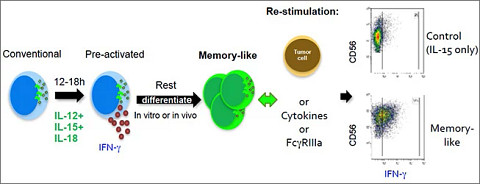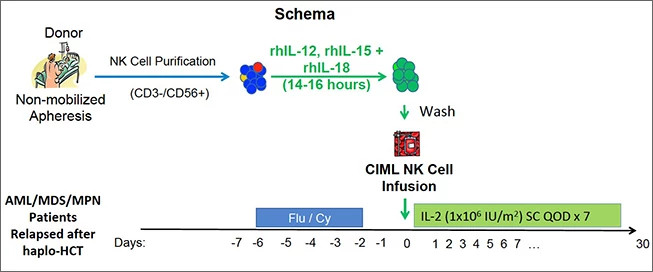Natural Killer (NK) cells are lymphoid cells with intrinsic antiviral and antitumor activity. NK cell function is normally regulated by key receptors, including inhibitory killer immunoglobulin-like receptors (KIRs), some of which recognize major histocompatibility complex (MHC) class I ligands. Prior clinical trials of NK cell products have met with limited success due to these cells' limited expansion, persistence, and activity after adoptive transfer.
While NK cells have traditionally been considered not to have "memory" cells akin to long-lived T and B cells, recent studies have identified memory-like properties that may be able to be exploited therapeutically. We described human cytokine-induced memory-like (CIML) NK cells generated by brief ex vivo activation with interleukin (IL)-12, IL-15, and IL-18 (Romee et al, Blood 2012). CIML NK cells have enhanced ability to recognize and kill leukemia targets (Figure 1). In our recent first-in-human study in patients with relapsed or refractory acute myeloid leukemia (AML), infusion of CIML NK cells was safe and 7 out of 11 evaluable AML patients had a clinical response, including 6 complete remissions (Romee et al, Science TM, 2016).

Conventional NK cells pre-activated with IL-12+IL-15+IL-18 for 16 hours return to a basal activation status, but upon re-stimulation exhibit enhanced IFN-γ production. Representative flow plots showing increased IFN-γ in pre-activated compared to control NK cells after 7 days of rest, followed by re-stimulation with cytokines for 6 hours.
Haploidentical hematopoietic cell transplantation (haplo-HCT) offers the ability to transplant patients lacking HLA-matched donors. Malignant relapse remains the major risk, with a very poor prognosis. Relapses after haplo-HCT are usually treated by donor lymphocyte infusion (DLI); however, remissions are infrequent and typically short-lived, and graft-versus-host disease (GVHD) toxicity is common.
We have recently developed a novel phase 1 clinical trial using CIML NK cells for patients with AML, myelodysplastic syndrome (MDS), or myeloproliferative neoplasms (MPN) that has relapsed after haplo-HCT. The post-transplant setting allows for the infused cells to expand and persist within the immune-compatible haplo-donor hematopoietic graft. CIML NK cells could also reduce DLI toxicity in relapsed patients, as these cells inhibit effector T cell-induced GVHD in pre-clinical mouse models. The study is aimed at demonstrating safety and a potential efficacy signal of using these cells in the post-transplant relapse setting.
CIML NK cells are generated from the original stem cell donor NK cells at Dana-Farber's recently expanded GMP lab, (The Connell and O'Reilly Families Cell Manipulation Core Facility). The cells are infused after patients receive a lymphodepleting conditioning regimen (fludarabine and cyclophosphamide). Patients also receive low-dose IL-2 subcutaneously every other day for 12 days to help further activate and proliferate adoptively transferred cells. Using multicolor flow and mass cytometry, we intend to track persistence, expansion, activation status, and anti-leukemia function of adoptively transferred CIML NK cells.
We are also developing a clinical trial using CIML NK cell therapy early after transplant to potentially decrease risk of relapse in patients with high risk hematological malignancies (e.g., AML patients with TP53 mutations, minimal residual disease (MRD)-positive patients). Other trials using CIML NK cells in combination with novel agents like IL-15 and checkpoint blockade are also planned for the near future at Dana-Farber, particularly in patients with advanced solid tumors.

Learn more about Dana-Farber's Cellular Therapies Program.
